sensor TOYOTA VERSO 2016 Owner's Manual
[x] Cancel search | Manufacturer: TOYOTA, Model Year: 2016, Model line: VERSO, Model: TOYOTA VERSO 2016Pages: 664, PDF Size: 62.24 MB
Page 258 of 664
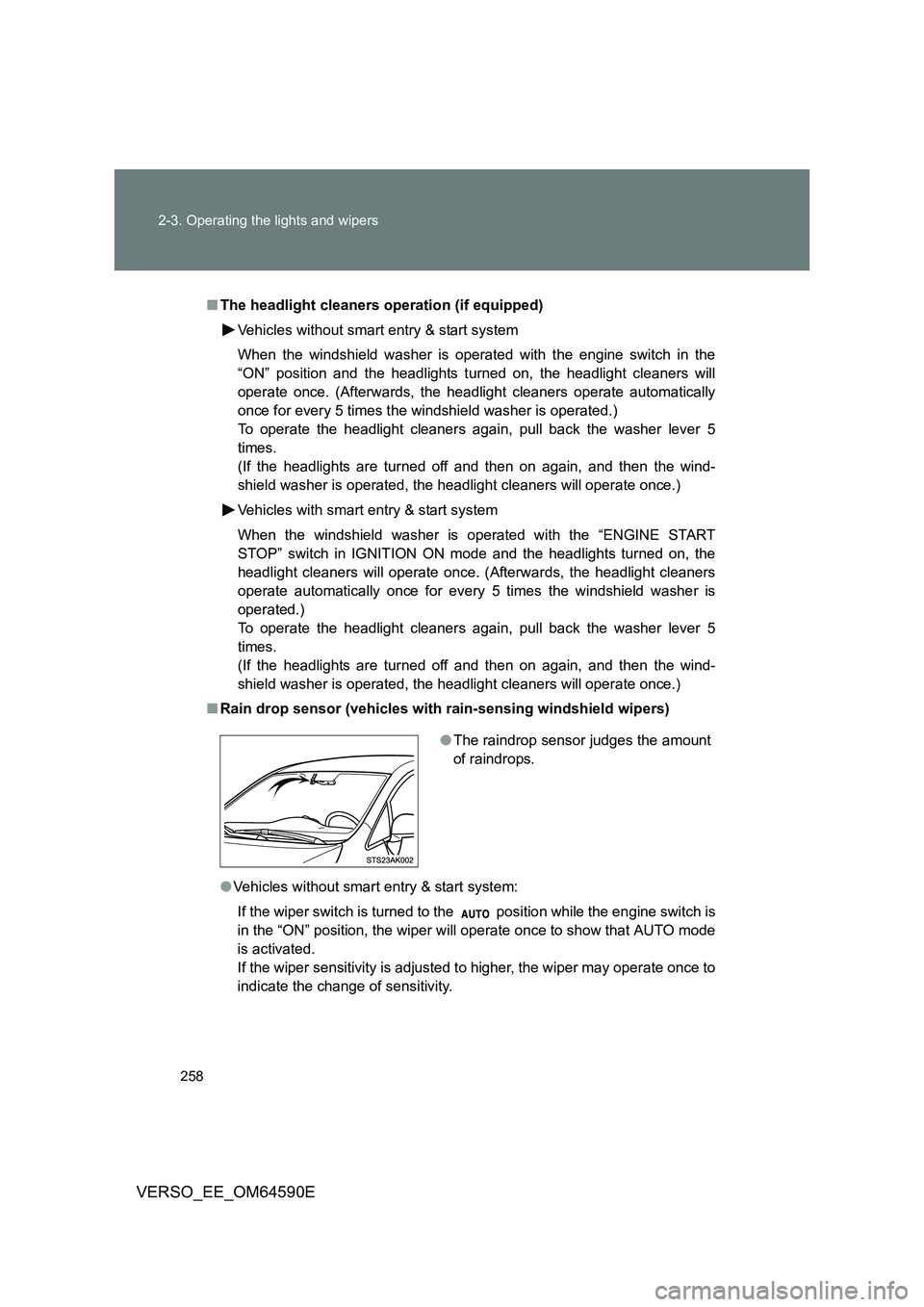
258
2-3. Operating the lights and wipers
VERSO_EE_OM64590E
■ The headlight cleaners operation (if equipped)
Vehicles without smart entry & start system
When the windshield washer is operat ed with the engine switch in the
“ON” position and the headlights turned on, the headlight cleaners will
operate once. (Afterwards, the headlight cleaners operate automatically
once for every 5 times the windshield washer is operated.)
To operate the headlight cleaners again, pull back the washer lever 5
times.
(If the headlights are turned off and then on again, and then the wind-
shield washer is operated, the headlight cleaners will operate once.)
Vehicles with smart entry & start system
When the windshield washer is operated with the “ENGINE START
STOP” switch in IGNITION ON mode and the headlights turned on, the
headlight cleaners will operate once. (Afterwards, the headlight cleaners
operate automatically once for every 5 times the windshield washer is
operated.)
To operate the headlight cleaners again, pull back the washer lever 5
times.
(If the headlights are turned off and then on again, and then the wind-
shield washer is operated, the headlight cleaners will operate once.)
■ Rain drop sensor (vehicles with rain-sensing windshield wipers)
● Vehicles without smart entry & start system:
If the wiper switch is turned to the position while the engine switch is
in the “ON” position, the wiper will operate once to show that AUTO mode
is activated.
If the wiper sensitivity is adjusted to higher, the wiper may operate once to
indicate the change of sensitivity.
● The raindrop sensor judges the amount
of raindrops.
Page 259 of 664
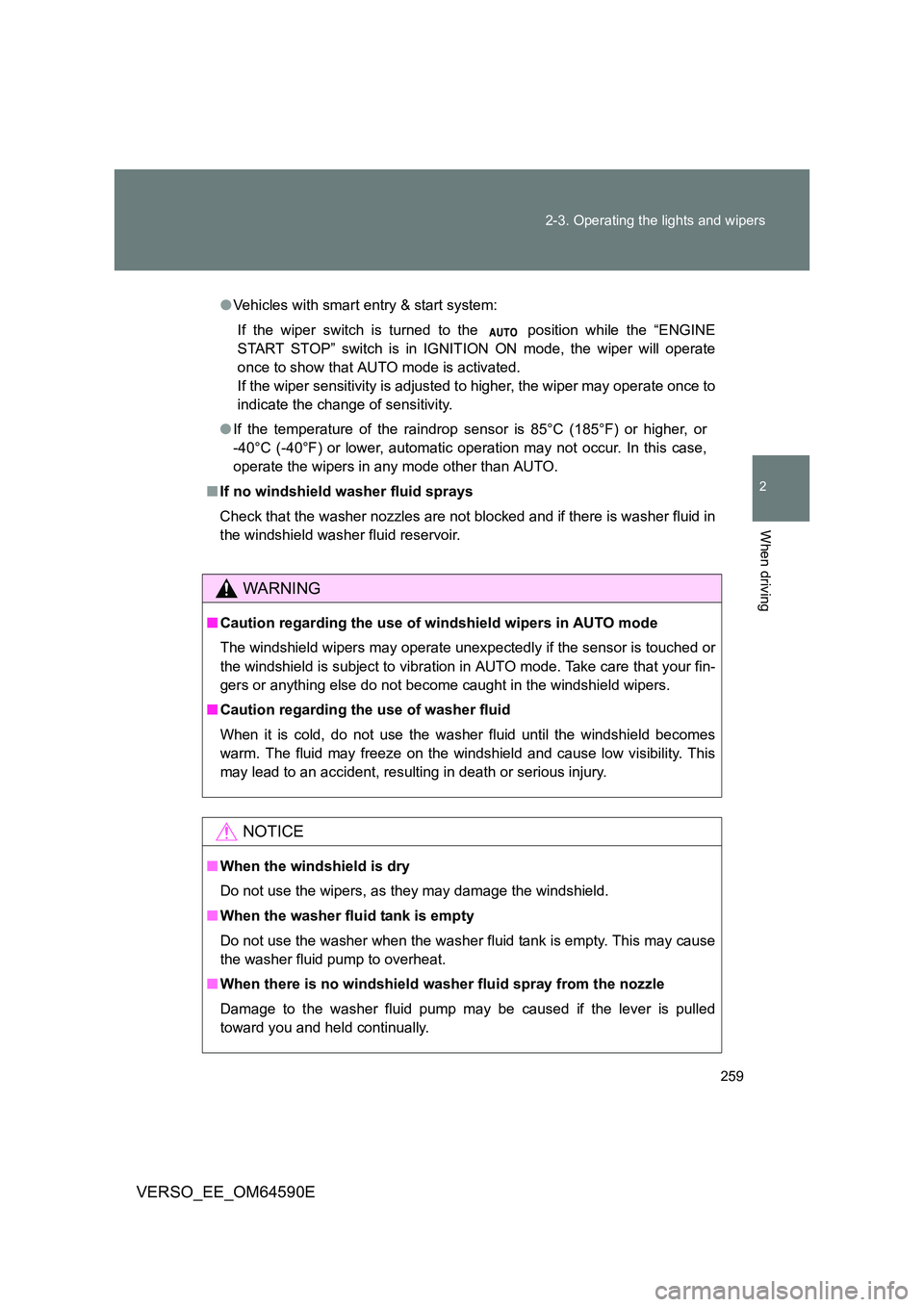
259
2-3. Operating the lights and wipers
2
When driving
VERSO_EE_OM64590E
● Vehicles with smart entry & start system:
If the wiper switch is turned to the position while the “ENGINE
START STOP” switch is in IGNITION ON mode, the wiper will operate
once to show that AUTO mode is activated.
If the wiper sensitivity is adjusted to higher, the wiper may operate once to
indicate the change of sensitivity.
● If the temperature of the raindrop sensor is 85°C (185°F) or higher, or
-40°C (-40°F) or lower, automatic operation may not occur. In this case,
operate the wipers in any mode other than AUTO.
■ If no windshield washer fluid sprays
Check that the washer nozzles are not blocked and if there is washer fluid in
the windshield washer fluid reservoir.
WARNING
■ Caution regarding the use of windshield wipers in AUTO mode
The windshield wipers may operate unexpectedly if the sensor is touched or
the windshield is subject to vibration in AUTO mode. Take care that your fin-
gers or anything else do not become caught in the windshield wipers.
■ Caution regarding the use of washer fluid
When it is cold, do not use the washer fluid until the windshield becomes
warm. The fluid may freeze on the winds hield and cause low visibility. This
may lead to an accident, resulting in death or serious injury.
NOTICE
■ When the windshield is dry
Do not use the wipers, as they may damage the windshield.
■ When the washer fluid tank is empty
Do not use the washer when the washer fluid tank is empty. This may cause
the washer fluid pump to overheat.
■ When there is no windshield washer fluid spray from the nozzle
Damage to the washer fluid pump may be caused if the lever is pulled
toward you and held continually.
Page 263 of 664
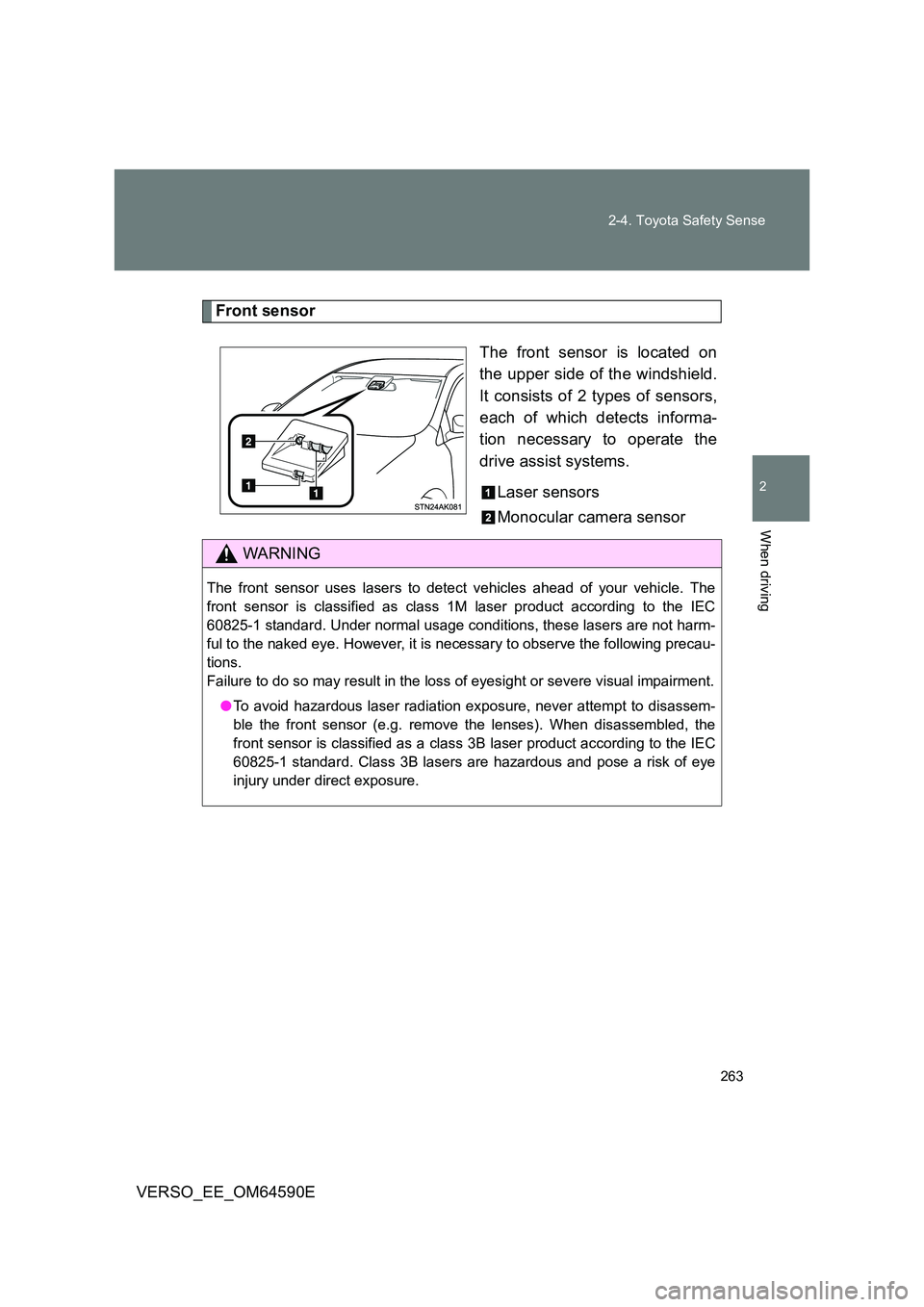
263
2-4. Toyota Safety Sense
2
When driving
VERSO_EE_OM64590E
Front sensor
The front sensor is located on
the upper side of the windshield.
It consists of 2 types of sensors,
each of which detects informa-
tion necessary to operate the
drive assist systems.
Laser sensors
Monocular camera sensor
2
WARNING
The front sensor uses lasers to detect vehicles ahead of your vehicle. The
front sensor is classified as class 1M laser product according to the IEC
60825-1 standard. Under normal usage condi tions, these lasers are not harm-
ful to the naked eye. However, it is necessary to observe the following precau-
tions.
Failure to do so may result in the loss of eyesight or severe visual impairment.
● To avoid hazardous laser radiation exposure, never attempt to disassem-
ble the front sensor (e.g. remove the lenses). When disassembled, the
front sensor is classified as a class 3B laser product according to the IEC
60825-1 standard. Class 3B lasers are hazardous and pose a risk of eye
injury under direct exposure.
Page 264 of 664
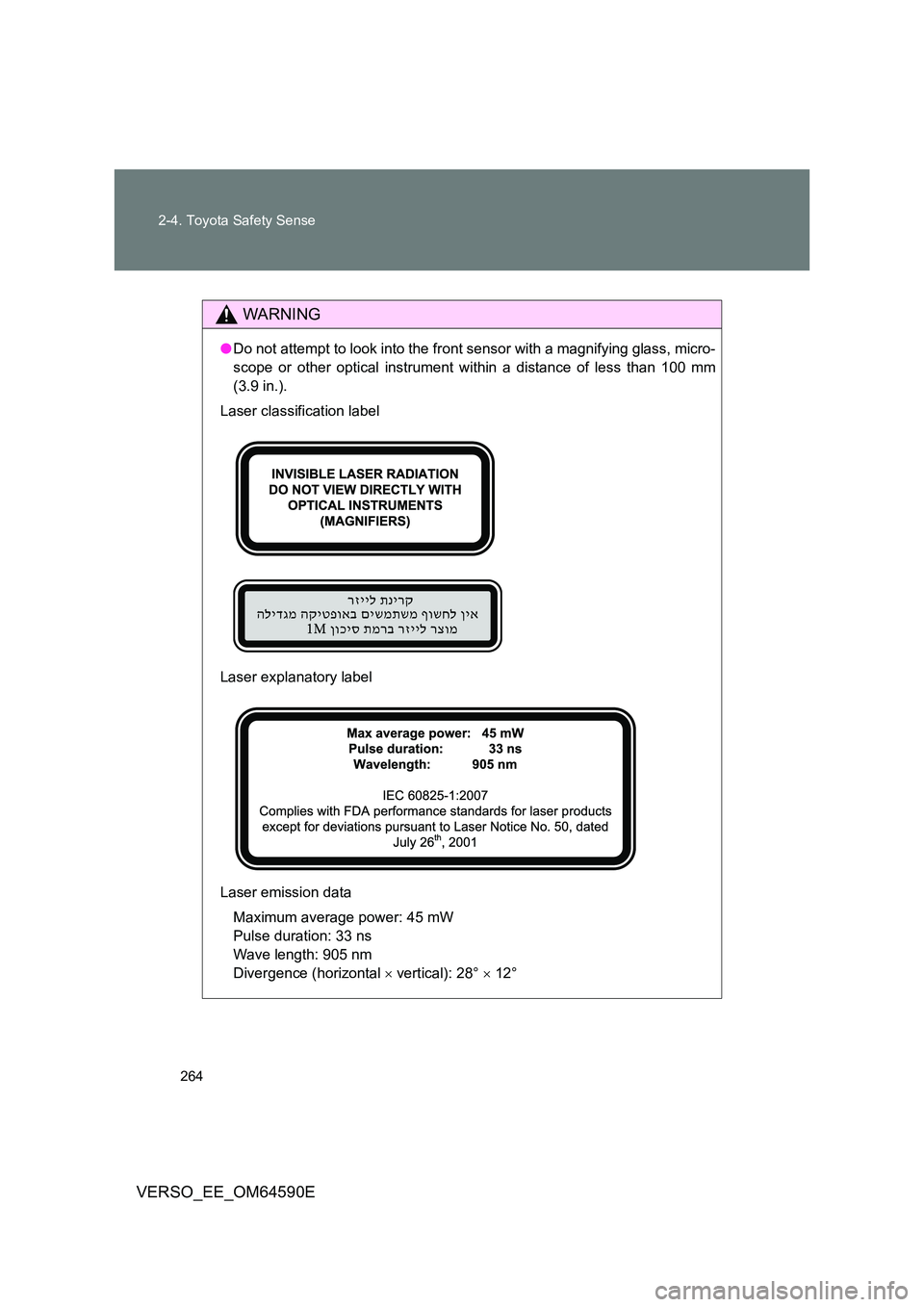
264
2-4. Toyota Safety Sense
VERSO_EE_OM64590E
WARNING
● Do not attempt to look into the front sensor with a magnifying glass, micro-
scope or other optical instrument within a distance of less than 100 mm
(3.9 in.).
Laser classification label
Laser explanatory label
Laser emission data
Maximum average power: 45 mW
Pulse duration: 33 ns
Wave length: 905 nm
Divergence (horizontal vertical): 28° 12°
Page 265 of 664
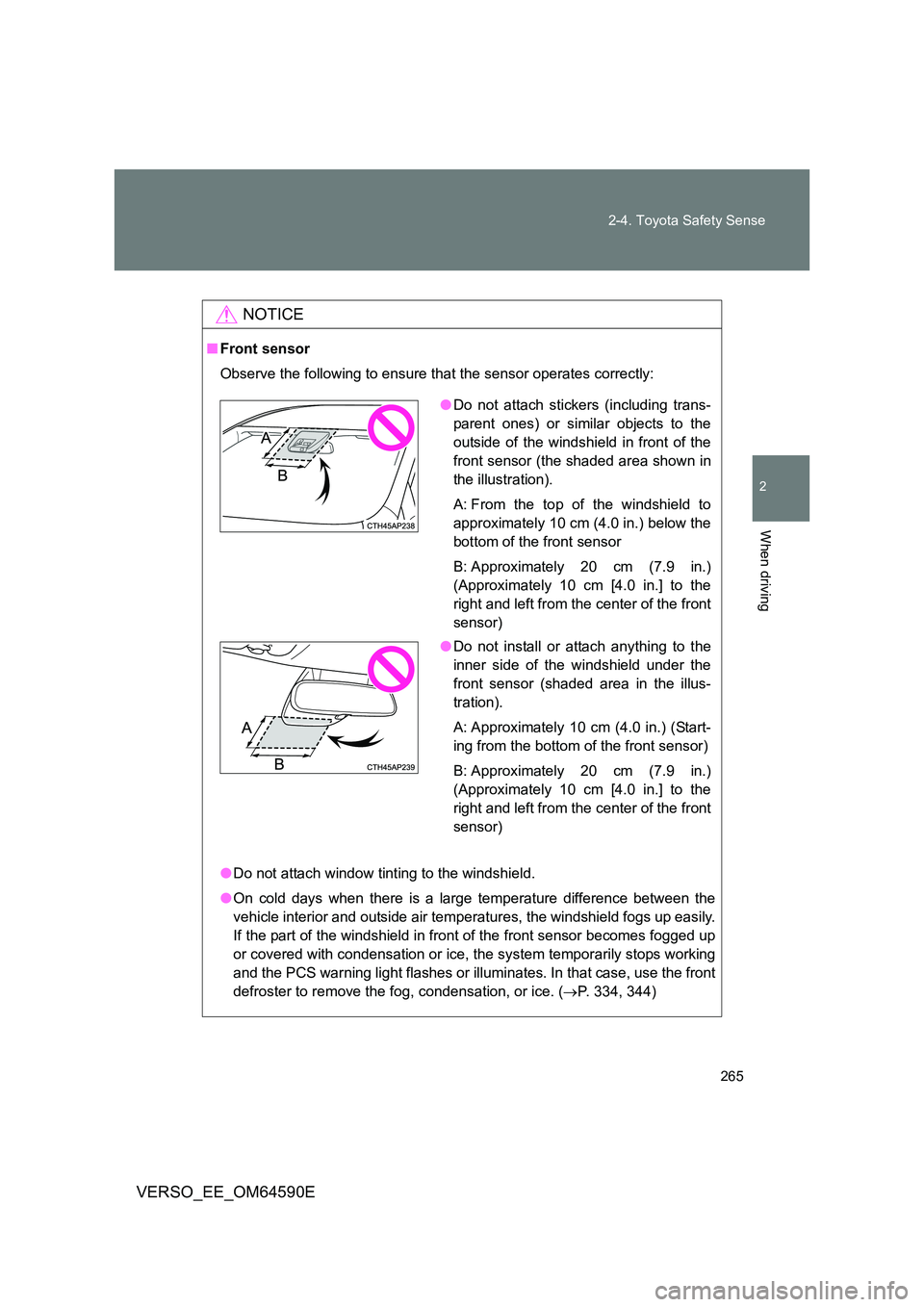
265
2-4. Toyota Safety Sense
2
When driving
VERSO_EE_OM64590E
NOTICE
■ Front sensor
Observe the following to ensure that the sensor operates correctly:
● Do not attach window tinting to the windshield.
● On cold days when there is a large temperature difference between the
vehicle interior and outside air temperatures, the windshield fogs up easily.
If the part of the windshield in front of the front sensor becomes fogged up
or covered with condensation or ice, the system temporarily stops working
and the PCS warning light flashes or illuminates. In that case, use the front
defroster to remove the fog, condensation, or ice. ( P. 334, 344)
●Do not attach stickers (including trans-
parent ones) or similar objects to the
outside of the windshield in front of the
front sensor (the shaded area shown in
the illustration).
A: From the top of the windshield to
approximately 10 cm (4.0 in.) below the
bottom of the front sensor
B: Approximately 20 cm (7.9 in.)
(Approximately 10 cm [4.0 in.] to the
right and left from the center of the front
sensor)
● Do not install or attach anything to the
inner side of the windshield under the
front sensor (shaded area in the illus-
tration).
A: Approximately 10 cm (4.0 in.) (Start-
ing from the bottom of the front sensor)
B: Approximately 20 cm (7.9 in.)
(Approximately 10 cm [4.0 in.] to the
right and left from the center of the front
sensor)
Page 266 of 664
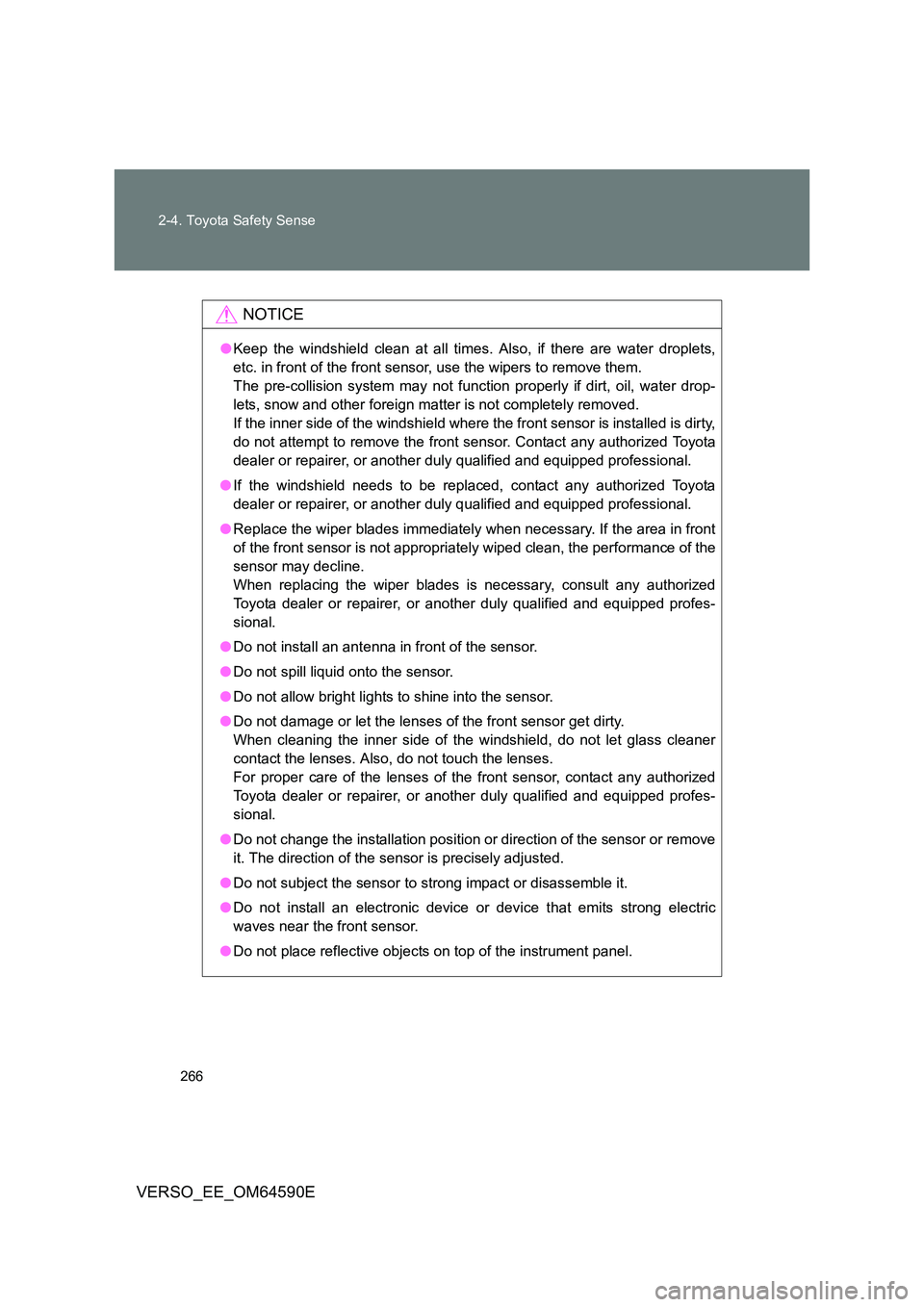
266
2-4. Toyota Safety Sense
VERSO_EE_OM64590E
NOTICE
● Keep the windshield clean at all times. Also, if there are water droplets,
etc. in front of the front sensor, use the wipers to remove them.
The pre-collision system may not func tion properly if dirt, oil, water drop-
lets, snow and other foreign matter is not completely removed.
If the inner side of the windshield where the front sensor is installed is dirty,
do not attempt to remove the front sensor. Contact any authorized Toyota
dealer or repairer, or another dul y qualified and equipped professional.
● If the windshield needs to be replaced, contact any authorized Toyota
dealer or repairer, or another dul y qualified and equipped professional.
● Replace the wiper blades immediately when necessary. If the area in front
of the front sensor is not appropriately wiped clean, the performance of the
sensor may decline.
When replacing the wiper blades is necessary, consult any authorized
Toyota dealer or repairer, or another duly qualified and equipped profes-
sional.
● Do not install an antenna in front of the sensor.
● Do not spill liquid onto the sensor.
● Do not allow bright lights to shine into the sensor.
● Do not damage or let the lenses of the front sensor get dirty.
When cleaning the inner side of the windshield, do not let glass cleaner
contact the lenses. Also, do not touch the lenses.
For proper care of the lenses of the front sensor, contact any authorized
Toyota dealer or repairer, or another duly qualified and equipped profes-
sional.
● Do not change the installation position or direction of the sensor or remove
it. The direction of the sensor is precisely adjusted.
● Do not subject the sensor to strong impact or disassemble it.
● Do not install an electronic device or device that emits strong electric
waves near the front sensor.
● Do not place reflective objects on top of the instrument panel.
Page 267 of 664
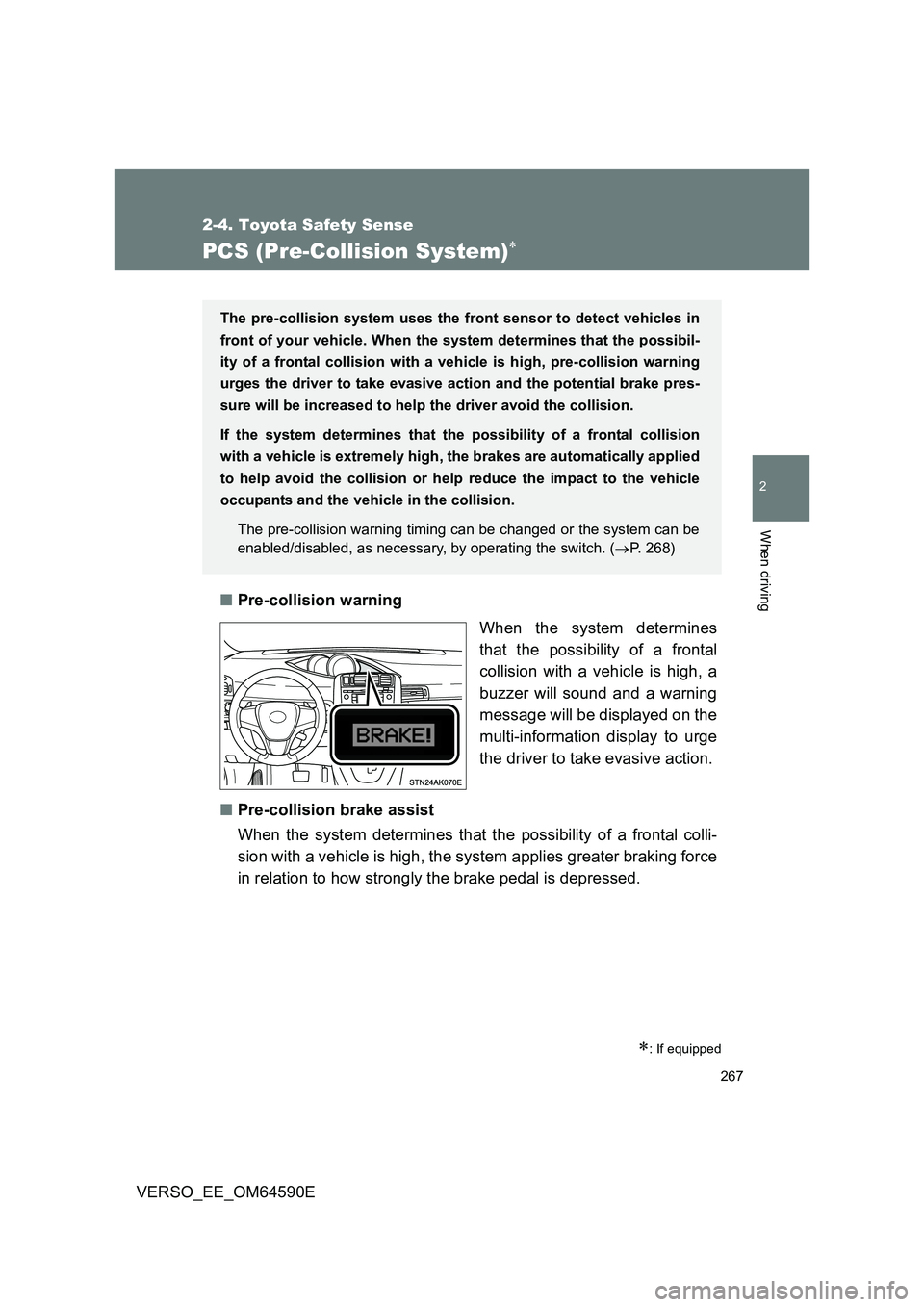
267
2-4. Toyota Safety Sense
2
When driving
VERSO_EE_OM64590E
PCS (Pre-Collision System)
■Pre-collision warning
When the system determines
that the possibility of a frontal
collision with a vehicle is high, a
buzzer will sound and a warning
message will be displayed on the
multi-information display to urge
the driver to take evasive action.
■ Pre-collision brake assist
When the system determines that the possibility of a frontal colli-
sion with a vehicle is high, the system applies greater braking force
in relation to how strongly the brake pedal is depressed.
: If equipped
The pre-collision system uses the front sensor to detect vehicles in
front of your vehicle. When the system determines that the possibil-
ity of a frontal collision with a vehicle is high, pre-collision warning
urges the driver to take evasive action and the potential brake pres-
sure will be increased to help the driver avoid the collision.
If the system determines that the possibility of a frontal collision
with a vehicle is extremely high, the brakes are automatically applied
to help avoid the collision or he lp reduce the impact to the vehicle
occupants and the vehicle in the collision.
The pre-collision warning timing can be changed or the system can be
enabled/disabled, as necessary, by operating the switch. ( P. 268)
Page 271 of 664
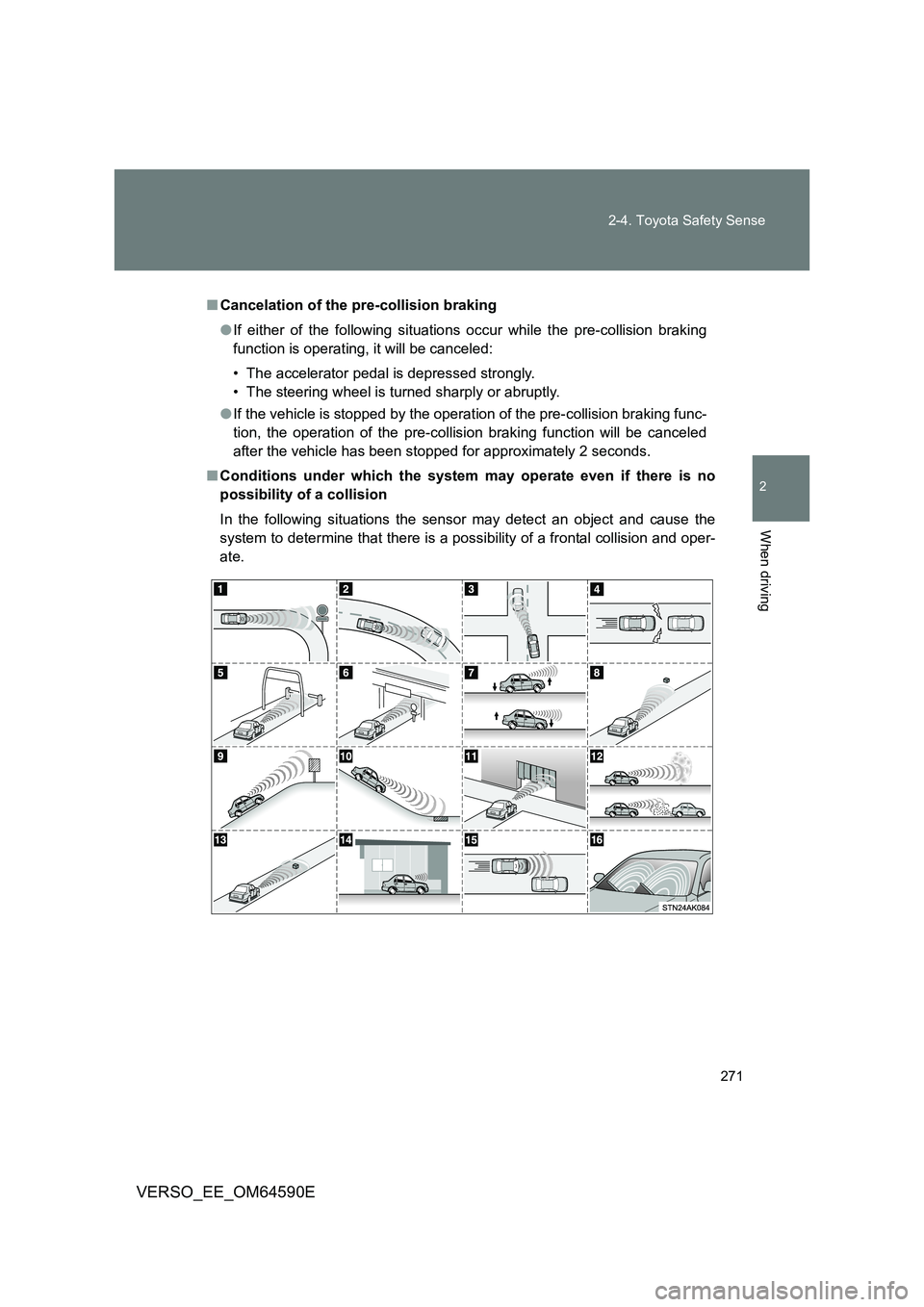
271
2-4. Toyota Safety Sense
2
When driving
VERSO_EE_OM64590E
■ Cancelation of the pre-collision braking
● If either of the following situations occur while the pre-collision braking
function is operating, it will be canceled:
• The accelerator pedal is depressed strongly.
• The steering wheel is tu rned sharply or abruptly.
● If the vehicle is stopped by the operation of the pre-collision braking func-
tion, the operation of the pre-collision braking function will be canceled
after the vehicle has been stopped for approximately 2 seconds.
■ Conditions under which the system may operate even if there is no
possibility of a collision
In the following situations the sensor may detect an object and cause the
system to determine that there is a possibility of a frontal collision and oper-
ate.
Page 272 of 664
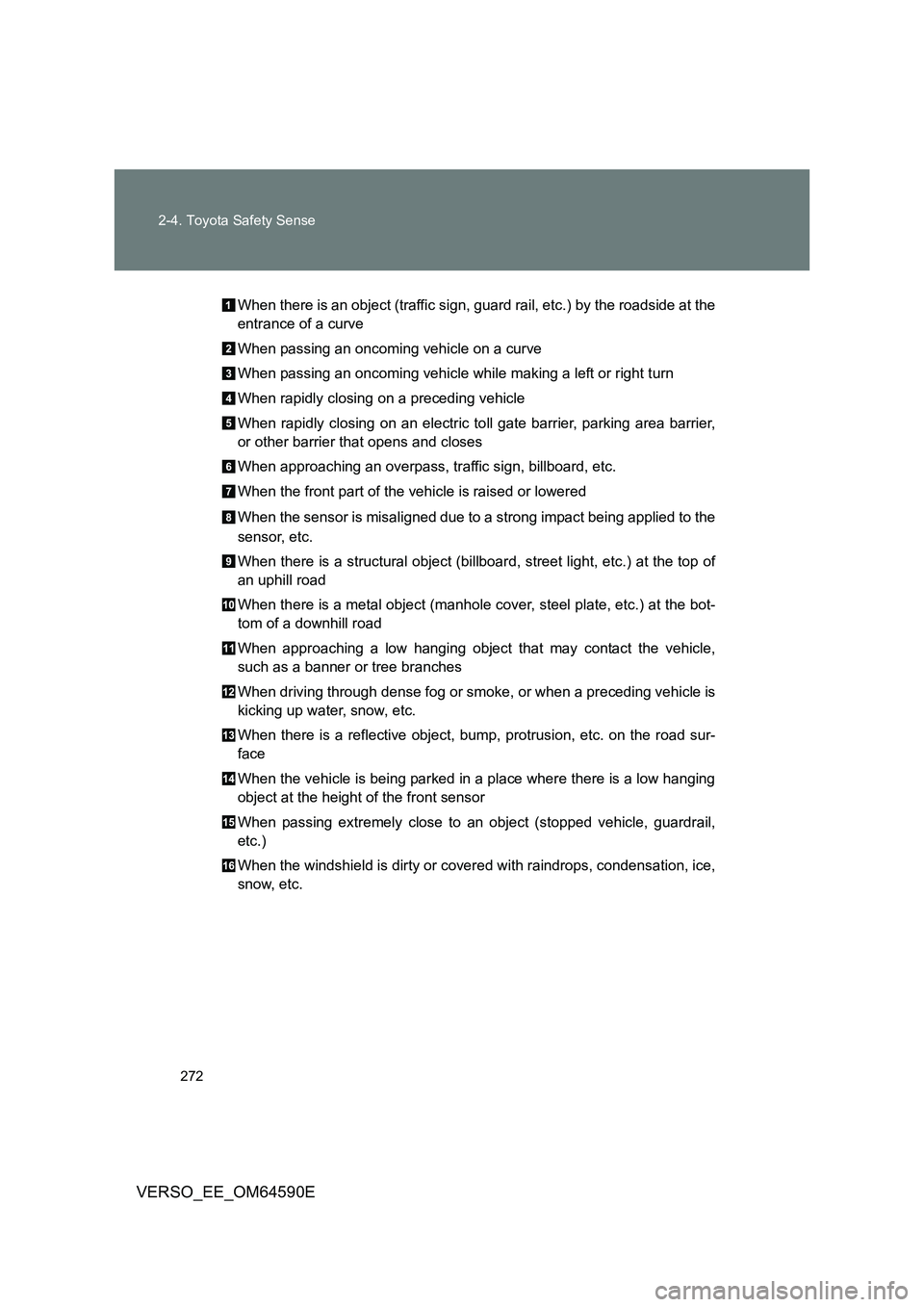
272
2-4. Toyota Safety Sense
VERSO_EE_OM64590E
When there is an object (traffic sign, guard rail, etc.) by the roadside at the
entrance of a curve
When passing an oncoming vehicle on a curve
When passing an oncoming vehicle while making a left or right turn
When rapidly closing on a preceding vehicle
When rapidly closing on an electric to ll gate barrier, parking area barrier,
or other barrier that opens and closes
When approaching an overpass, traffic sign, billboard, etc.
When the front part of the vehicle is raised or lowered
When the sensor is misaligned due to a strong impact being applied to the
sensor, etc.
When there is a structural object (billboard, street light, etc.) at the top of
an uphill road
When there is a metal object (manhole cove r, steel plate, etc.) at the bot-
tom of a downhill road
When approaching a low hanging object that may contact the vehicle,
such as a banner or tree branches
When driving through dense fog or smok e, or when a preceding vehicle is
kicking up water, snow, etc.
When there is a reflective object, bump, protrusion, etc. on the road sur-
face
When the vehicle is being parked in a place where there is a low hanging
object at the height of the front sensor
When passing extremely close to an object (stopped vehicle, guardrail,
etc.)
When the windshield is dirty or covered with raindrops, condensation, ice,
snow, etc.
Page 273 of 664
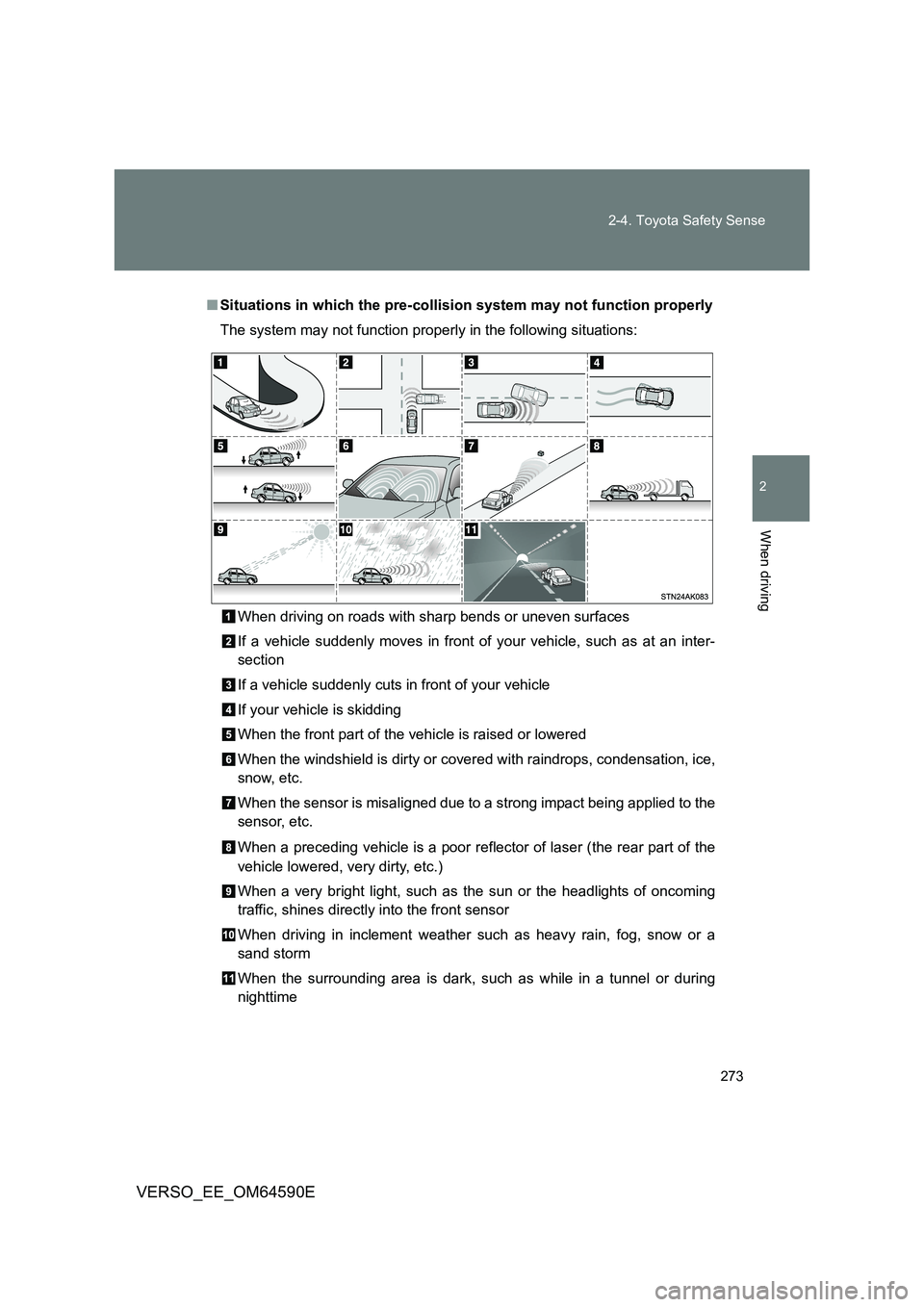
273
2-4. Toyota Safety Sense
2
When driving
VERSO_EE_OM64590E
■ Situations in which the pre-collision system may not function properly
The system may not function properly in the following situations:
When driving on roads with sharp bends or uneven surfaces
If a vehicle suddenly moves in front of your vehicle, such as at an inter-
section
If a vehicle suddenly cuts in front of your vehicle
If your vehicle is skidding
When the front part of the vehicle is raised or lowered
When the windshield is dirty or covered with raindrops, condensation, ice,
snow, etc.
When the sensor is misaligned due to a strong impact being applied to the
sensor, etc.
When a preceding vehicle is a poor reflector of laser (the rear part of the
vehicle lowered, very dirty, etc.)
When a very bright light, such as the sun or the headlights of oncoming
traffic, shines directly into the front sensor
When driving in inclement weather such as heavy rain, fog, snow or a
sand storm
When the surrounding area is dark, such as while in a tunnel or during
nighttime